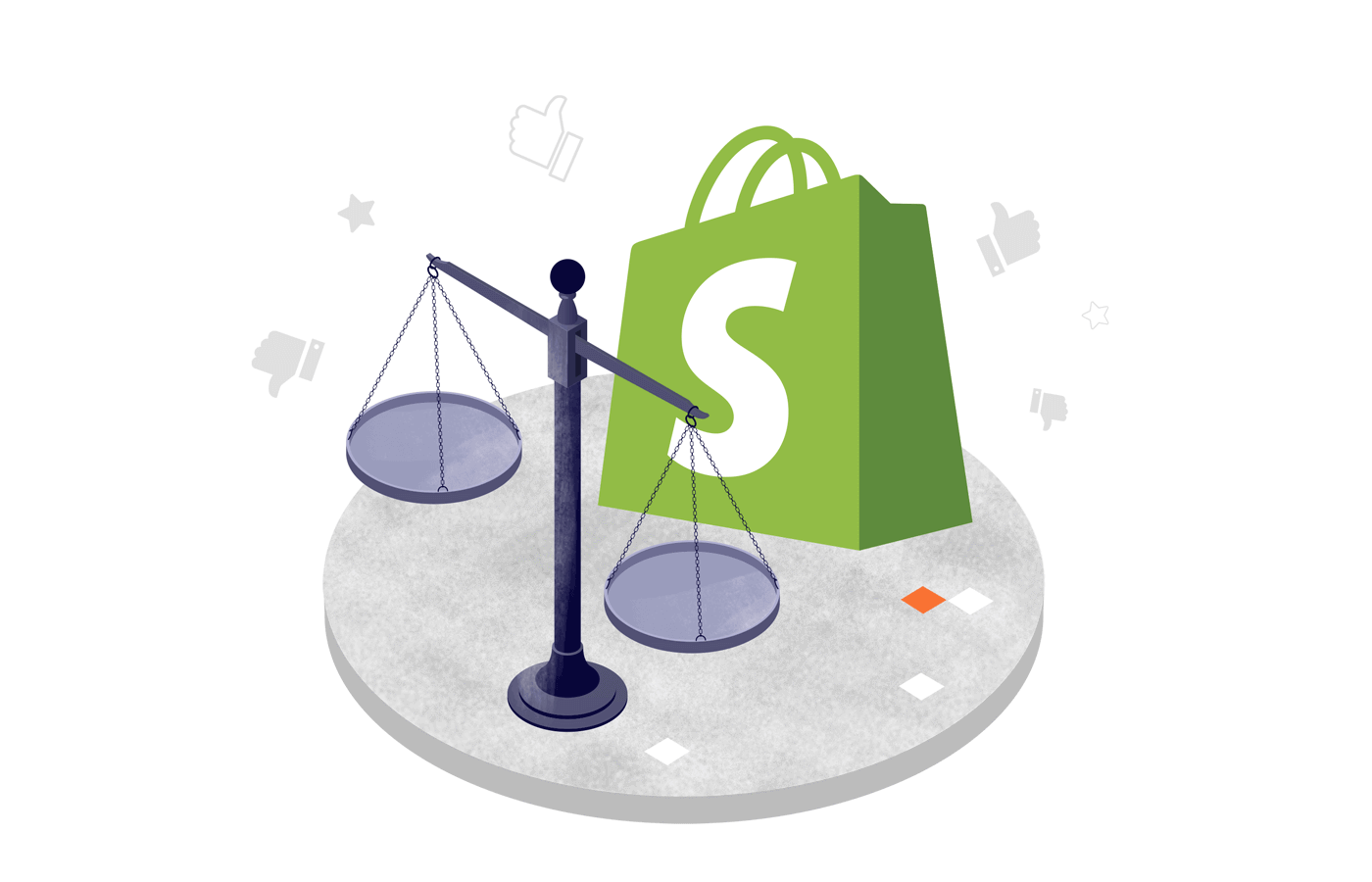As of 2024, there are more than 1.7 million merchants on Shopify, and just like you, they started off by searching for the best platform for their online store.
When it comes to creating and launching your own online store, Shopify may be a great choice for its ease of use. However, it’s important to weigh the advantages and disadvantages of this platform before making an investment that meets your business needs.
This review takes an in-depth look at Shopify, unraveling what makes this platform shine and where it might have a few hidden hiccups.
How Shopify Works?
Did you know that Shopify is more than just your run-of-the-mill online platform? It’s a dynamic powerhouse that empowers ecommerce sellers like you to build and maintain your own online store effortlessly.
Imagine having a vast collection of customizable website templates and easy-to-use themes at your fingertips. With Shopify, you can adapt these themes to create a store that perfectly aligns with your brand’s unique identity and vision.
But hold on, there’s more! Shopify isn’t just for those looking to conquer the digital realm. If you have a physical store, you can elevate your in-person and online selling experience with Shopify. It’s a versatile platform that caters to all types of sellers, making it a fantastic choice for bringing your business to life.
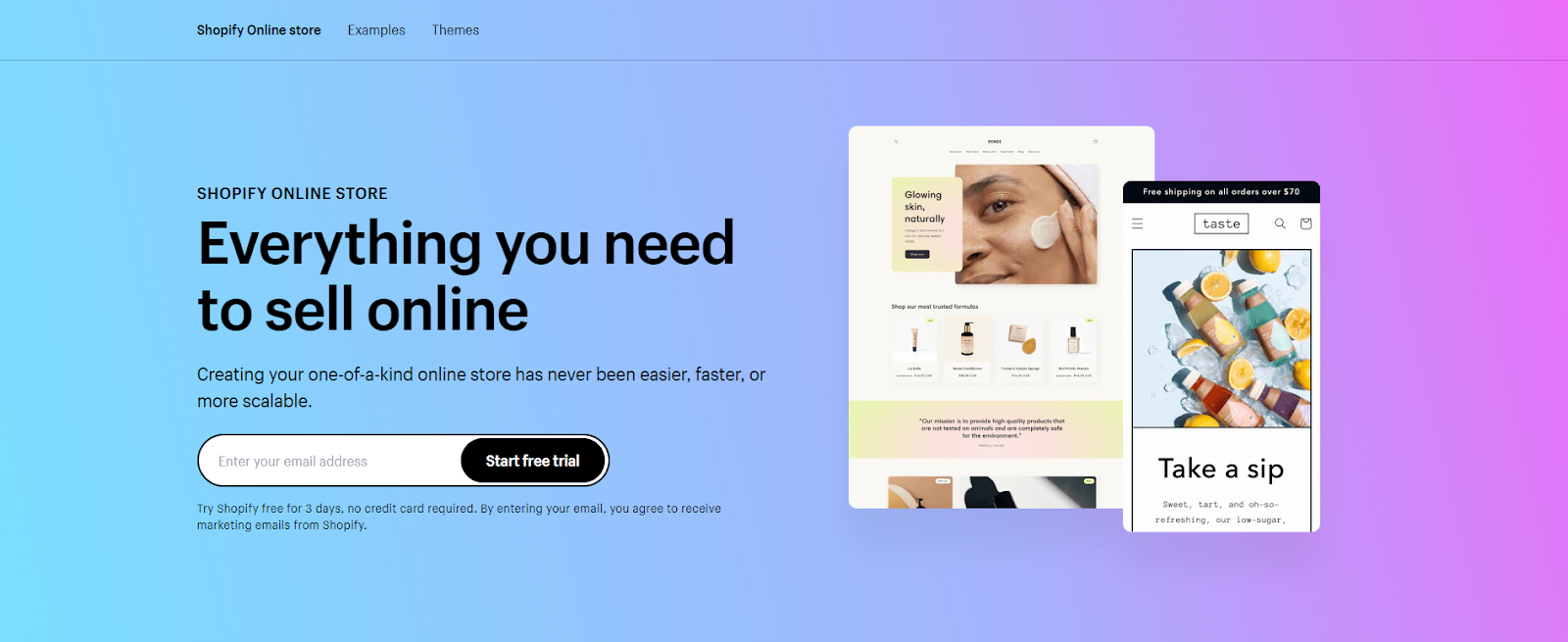
Shopify was designed with user-friendliness in mind. You don’t need any coding knowledge to build your Shopify store. In fact, you can create your store in a matter of minutes using their intuitive drag-and-drop interface. Say goodbye to the days of agonizing over code!
While Shopify offers a code-fee experience for coding novices, it doesn’t neglect seasoned developers. For those who would like to play around on the backend of their store, Shopify offers full access to programming languages like CSS and Liquid (Shopify’s very own coding language).
And here’s the cherry on top: Shopify’s ecommerce platform is a fully hosted solution. That means no need to fuss with downloading extra apps or paying for separate hosting. You can set up and run your store seamlessly through your web browser.
Shopify’s Main Features
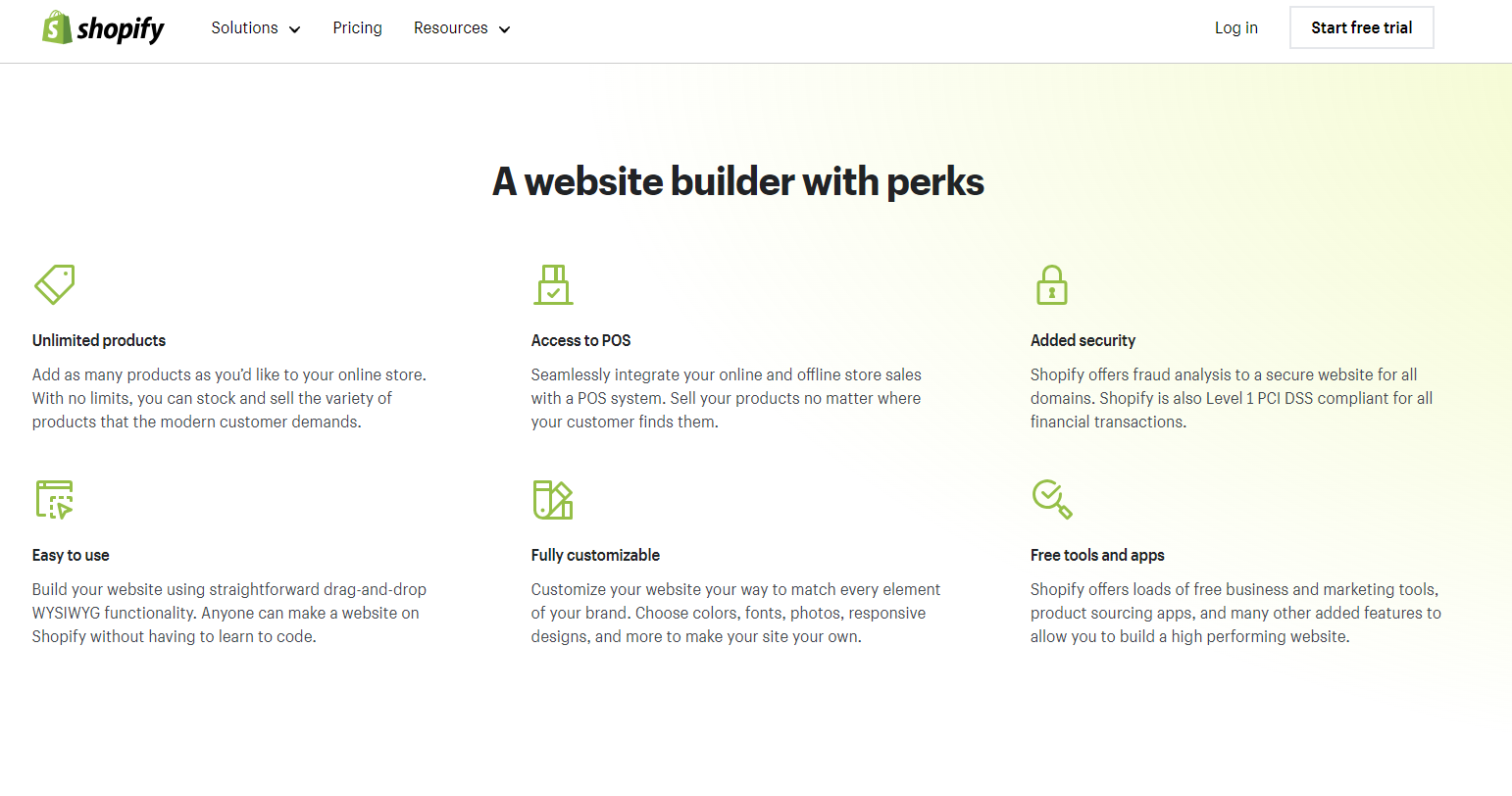
Shopify has several features to help you create a thriving ecommerce store. The platform’s overall goal is to provide a “one-stop shop” with all the resources you need:
- Shopify theme store: Over a hundred templates to choose from.
- Sales dashboard: Lets you oversee any aspect of your store.
- Centralized inventory tracking: Track and manage stock, orders, and payments easily.
- Shopify shipping: Provides access to global and regional carriers.
- Shopify app store: Install extra apps for more features in your store.
- Shopify blog: Helps you engage with your buyers.
- Shopify point of sale (POS): Supports physical selling with digital-led payments.
- Integrations and customization: To extend any aspect of your store.
You can easily integrate Shopify with email and SMS marketing tools, such as Sender.
We’ll discuss more about all of these features in a second. But first, let’s take a look at Shopify’s numbers – and why they matter.
The Number of Shopify Users
Shopify has a vast user base, providing an online selling haven to millions of users, including big-shots like Red Bull and countless small stores. Picture this: over 4 million websites across 170 countries use Shopify. It’s a huge global community of digital shops powered by the ecommerce tools and infrastructure of Shopify’s platform.
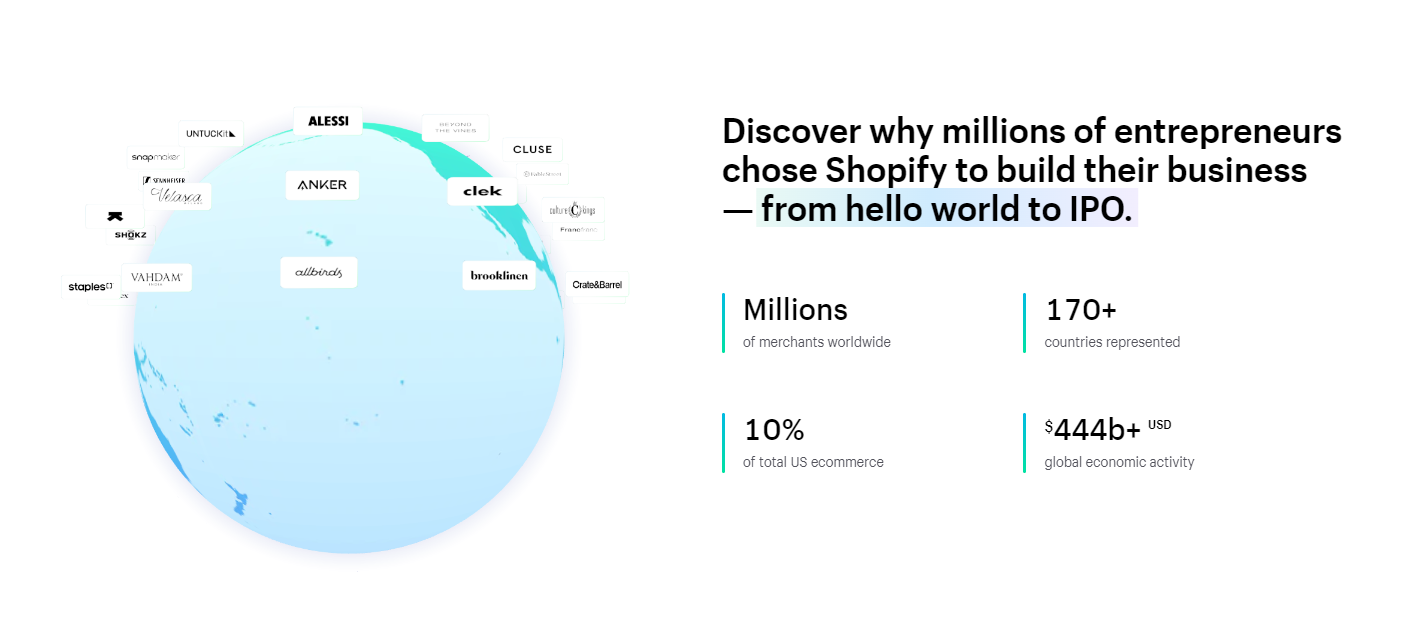
Because of the wide acceptance that Shopify enjoys, it’s far easier to succeed on the platform than elsewhere.
Imagine pouring your heart and soul into building and promoting your online store, only for it to fizzle out due to a lack of users or support. But, due to its large user base, Shopify offers a stable platform on which you can build confidently.
In addition, Shopify’s high-profile status makes it a big attraction for buyers. Consider this: in 2022, about 649 million people bought something from a Shopify store. That’s roughly 30% of the total number of people shopping online in 2023.
This network of buyers and sellers generates massive amounts of economic activity – up to $444 billion in 2021. So, it’s easy to understand why the platform is a big draw for many.
Now, let’s dig deeper into the pros and cons of using the platform.
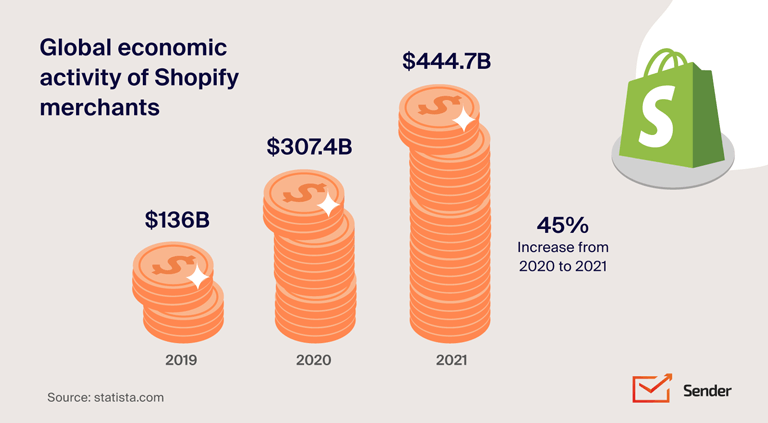
Pros of Using Shopify
Shopify’s pros are centered around the platform’s outstanding features and user-friendliness. Let’s take a look at each of these.
1. Ease of Use
A big part of Shopify’s appeal is its simplicity and ease of use. The platform has a modern, attractive interface and provides a good user experience. Most of Shopify’s functionality comes “out of the box”, meaning you don’t need to spend much time learning about or setting things up before you can use the platform.
Signing up on Shopify and getting started is extremely easy. You only need to answer some simple questions to help Shopify learn about you and offer features that fit your needs.
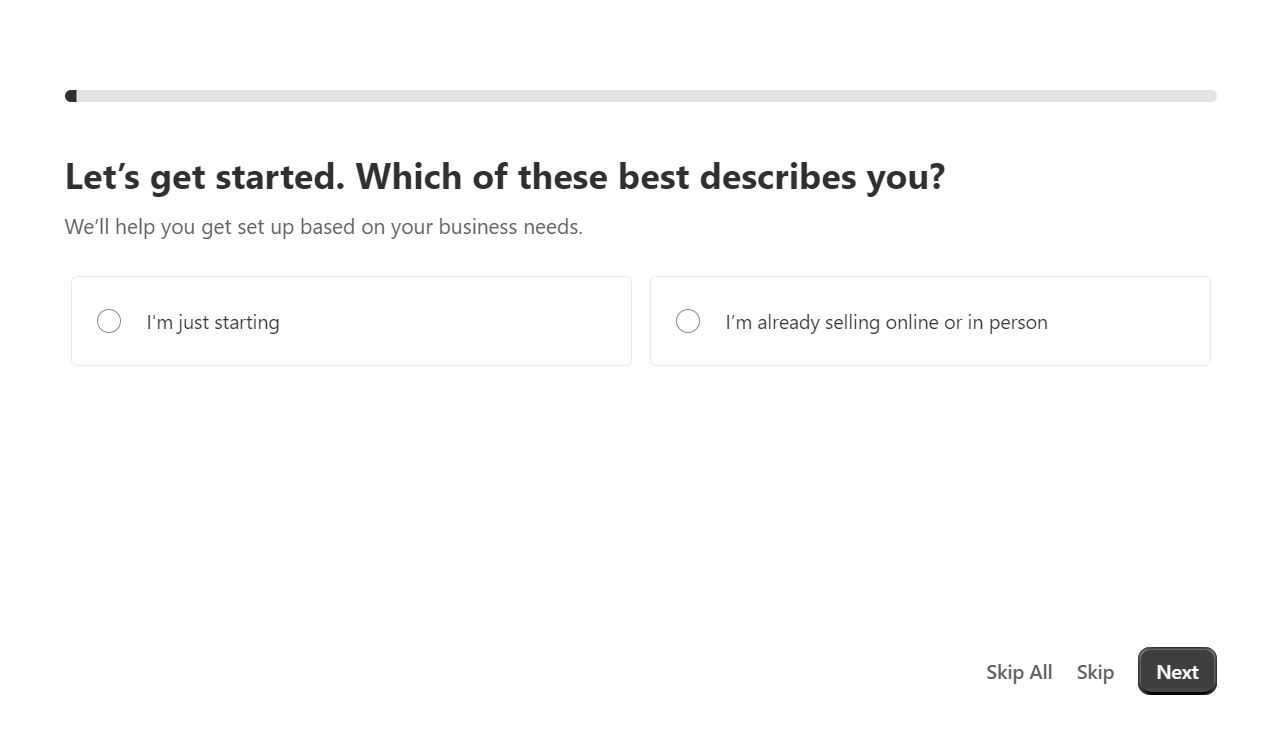
From here, there’s a straightforward pathway to opening your store, uploading product images and descriptions, and setting up shipping, payments, etc. Navigation is also simple – you can access most pages through the menu on the left side of your store dashboard.
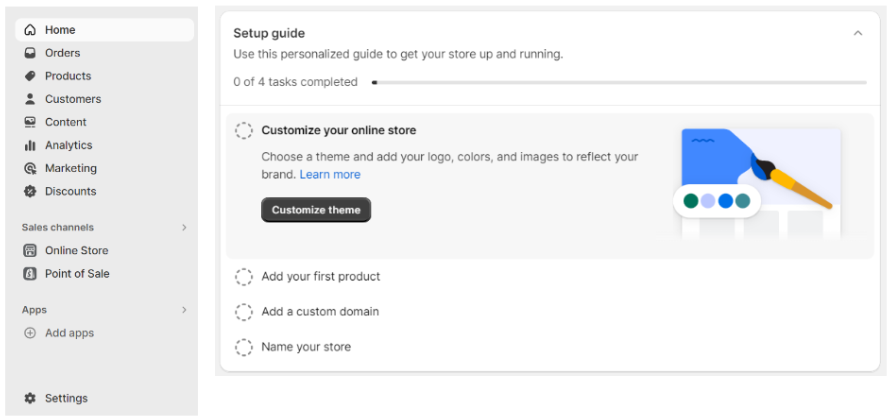
Shopify also offers an AI feature called Shopify Magic that generates product descriptions using any keywords you provide. This significantly cuts down on the time it takes to set up your product catalog.
2. Customization
Despite being a plug-and-play platform, Shopify also makes it very easy to customize your store and make it uniquely yours. There are several options available for customization, so you can choose the method that suits your needs and coding ability.
One of the easiest is by using Shopify apps. These handy tools allow you to add new features and functionalities. For example, you can find apps that offer advanced blogging capabilities beyond what Shopify provides or dropshipping tools to streamline your business operations. With the wide range of apps available, you can enhance your store’s functionality with just a few clicks.
If you want to change your store’s overall look and feel, the customization features of Shopify’s themes make these possible. You can add sections to various parts of your store, such as the header, banner, collection, and footer. With these, you can personalize the layout and design elements, making your store more visually appealing and aligning it with your brand.
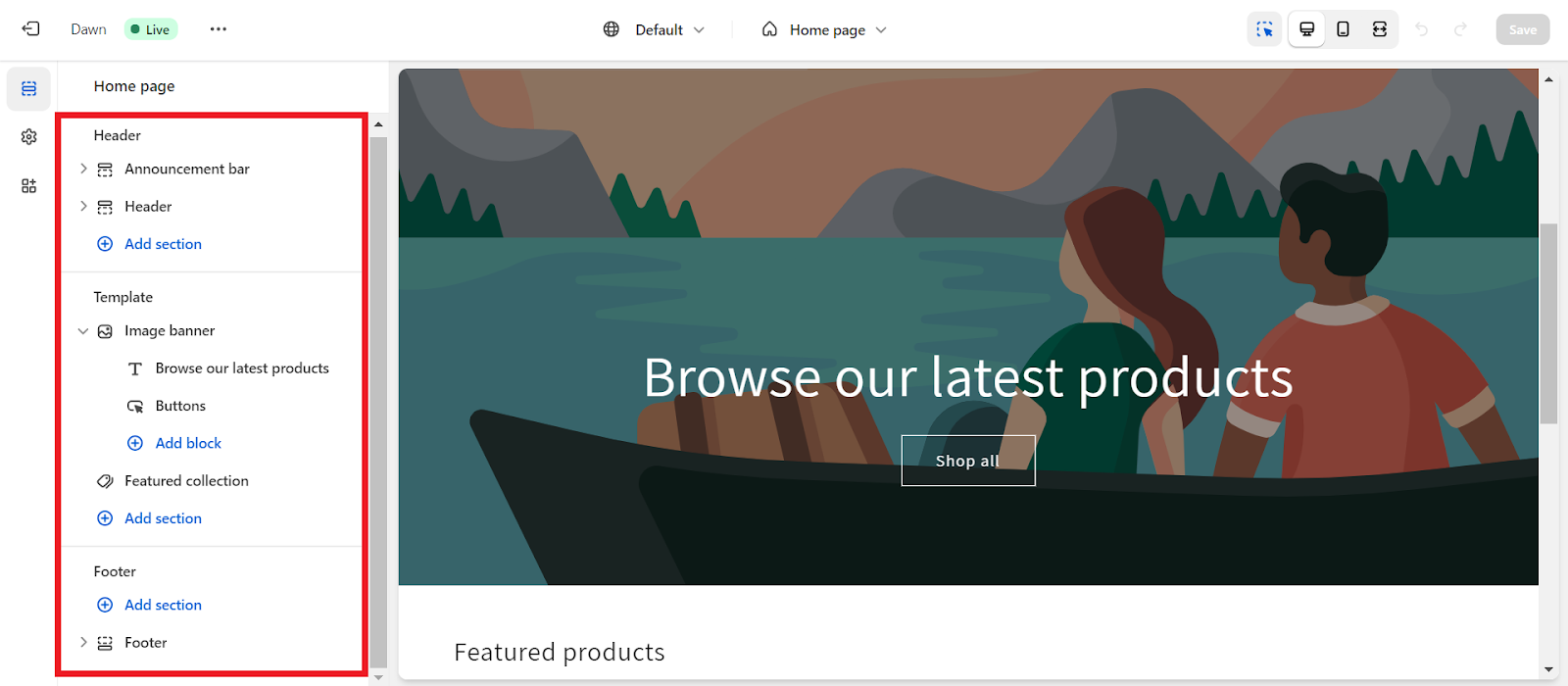
For those who want to go even further and make more specific updates, you can manually add code to your template. This gives you the freedom to make granular changes and tailor your store according to your preferences. For example, if you want to gather additional customer information, you can use HTML code to create custom fields like “line item properties.
Overall, there are various ways to customize your store, and Shopify offers different levels of tools for your use, depending on your coding ability.
Creating professional newsletters has never been so easy! With Sender, you can create professional emails in minutes, thanks to its drag-and-drop email builder and responsive templates
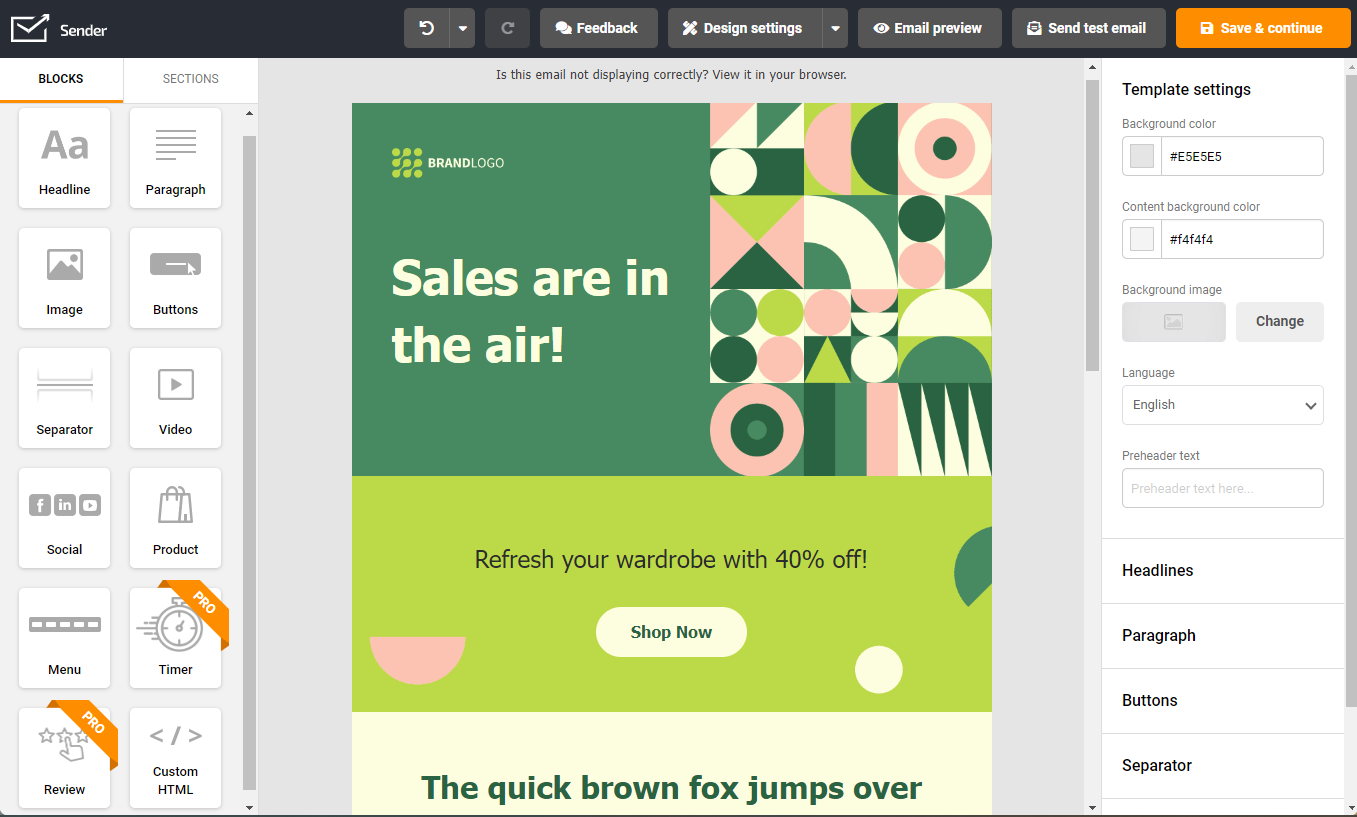
3. Shopify Payments
Shopify offers two main ways to accept payments on your store: Shopify Payments, which is Shopify’s built-in payments system, and third-party payment gateways like PayPal, AmazonPay, etc.
Shopify Payments is a cost-effective and stress-free payment processing option available to all users. It comes with your account, so there’s no need to worry about how to turn it on.
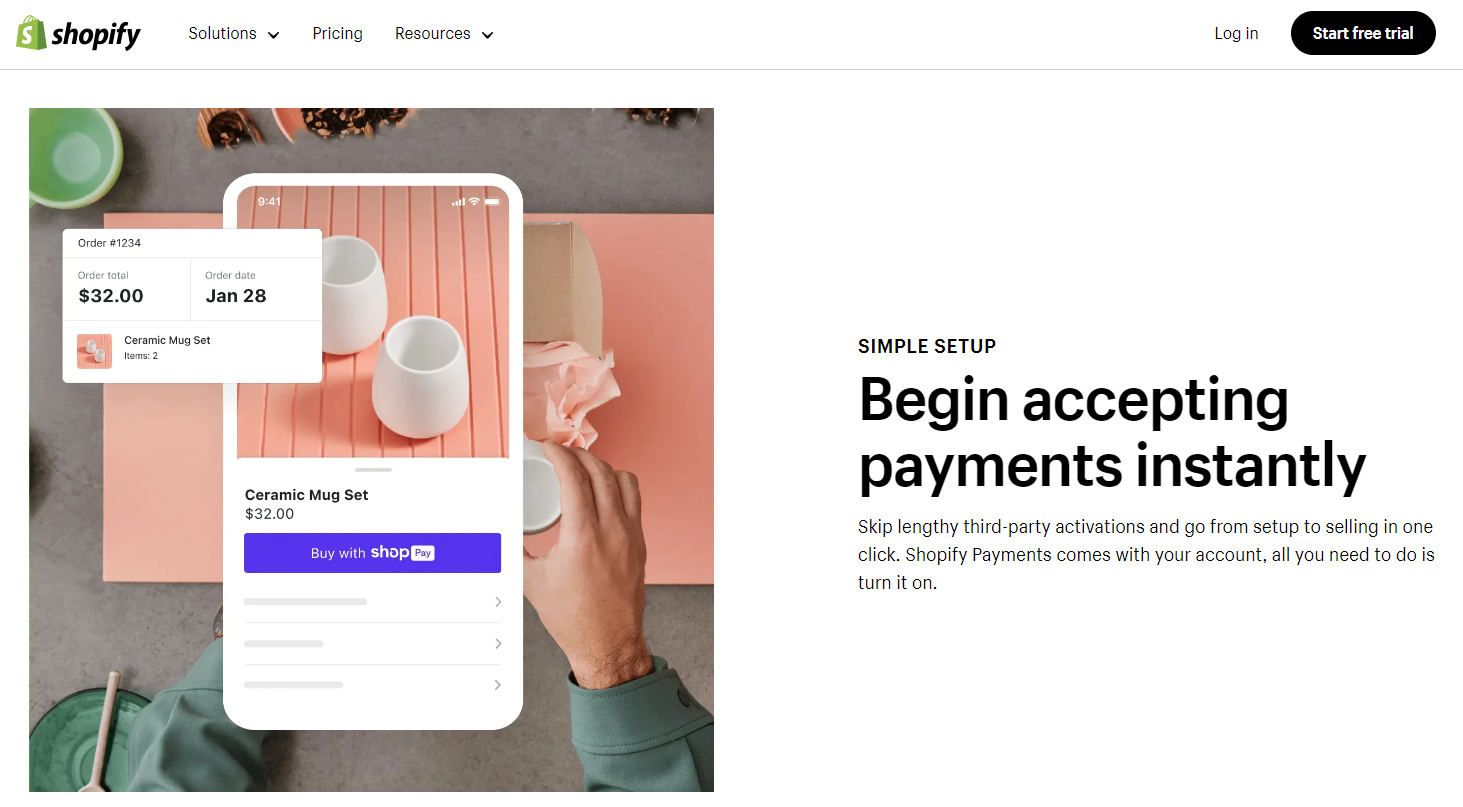
Using this payment processing method comes with several advantages. First of all, you don’t pay any transaction fees when using Shopify Payments. The only exception is for the “Starter” plan, which applies a 5% transaction fee on each sale using this method.
Additionally, you can skip lengthy third-party verification and activation when using Shopify’s payment solution. Plus, the payment option provides first-rate payment data encryption, and your customers’ payment details will be housed on PCI-compliant servers.
Customers selling from physical stores aren’t left out either. Using Shopify POS, they can enjoy Shopify’s digital payment processing, accept credit cards in-store, manage inventory, and see all of their data in one place.
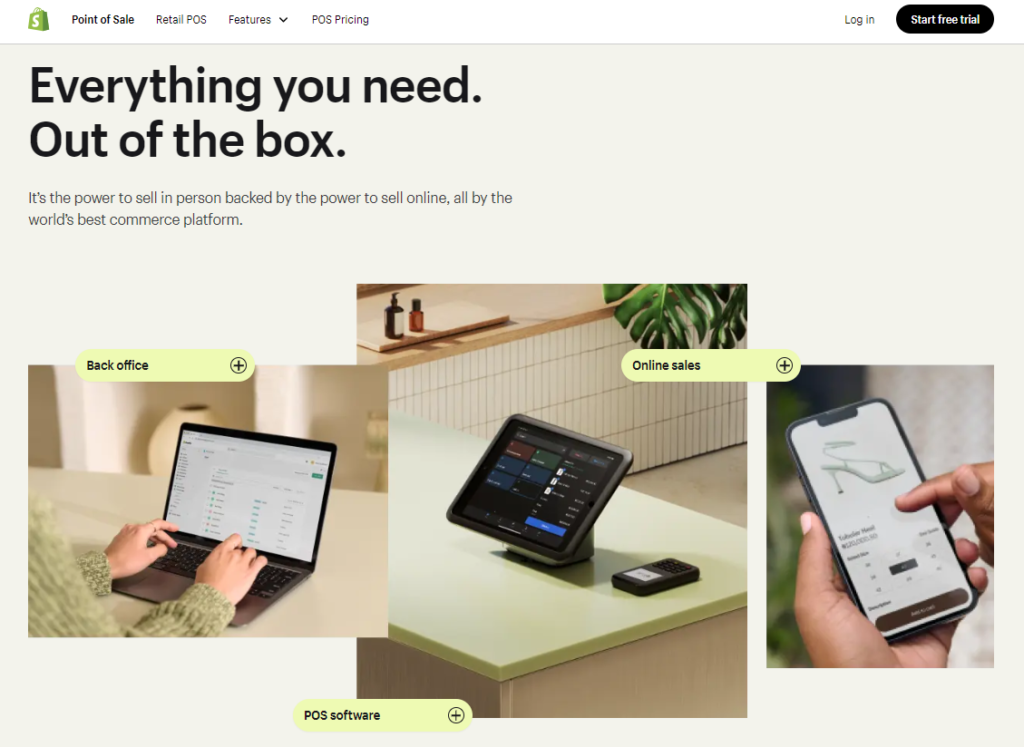
4. Variety of Themes
Shopify is well-known for its ecommerce templates, also called themes. The platform offers more than 150 well-designed and really clean templates to start with when designing your store.
These themes are available on the Shopify Theme Store. There you’ll find a collection of free and paid themes. Currently, the store offers 12 free themes, and the rest is around 150 paid themes. While the number of themes is really small compared to other platforms like Wix, which has 800+ themes, Shopify’s themes are top quality.
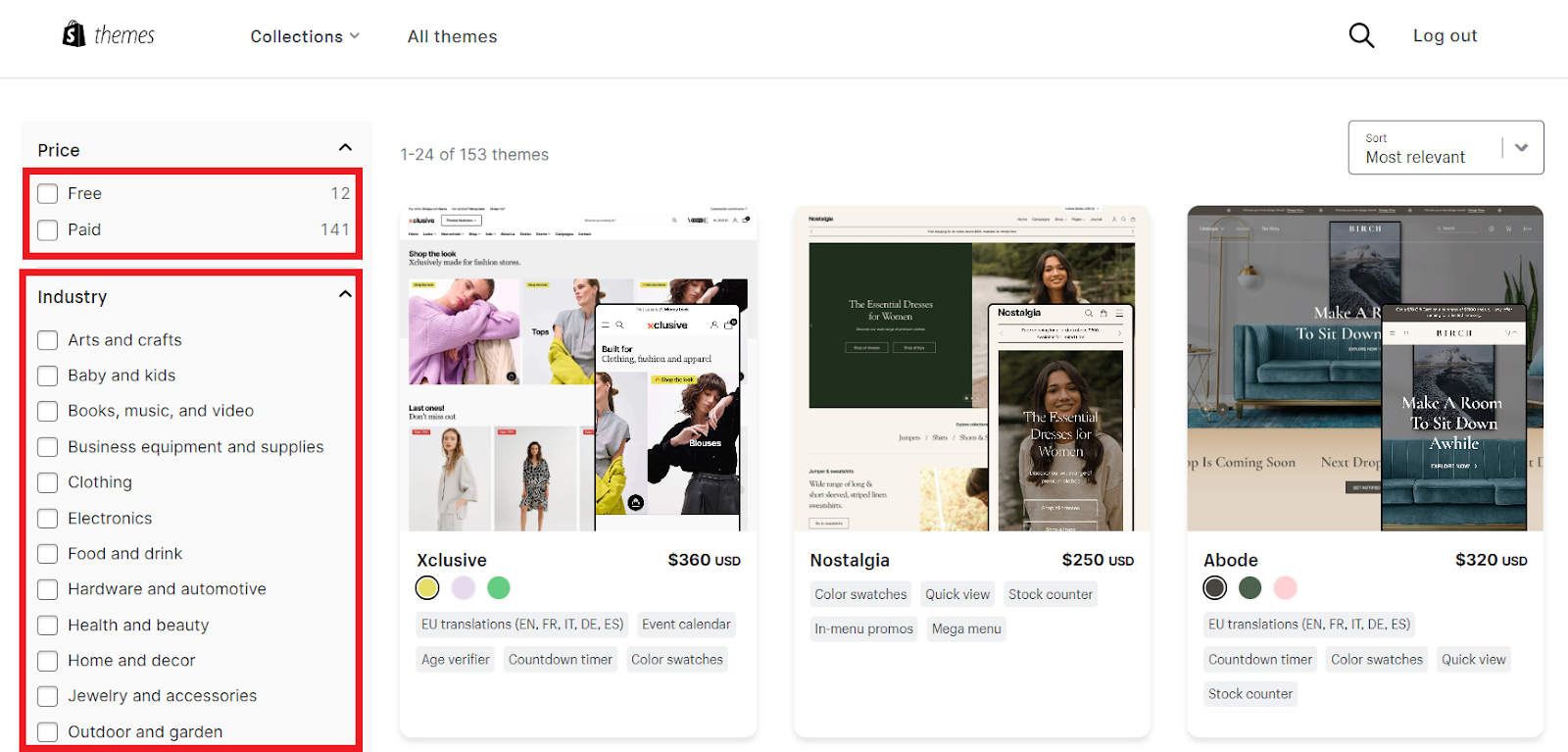
All of Shopify’s themes are fully responsive, meaning that they automatically adjust to whatever screen they’re being viewed on – tablet, smartphone, or computer. They also come with important SEO optimizations, including features like fast load speed and prominent CTAs.
Some themes were specifically designed to suit certain industries. So, if you’re, for instance, making jewelry you can find a tailored theme that fits your products and customers perfectly.
Most of the themes also come with a minimum of two to three variants, giving you even more variety to choose from.
If you ever come across a Shopify store with a theme that catches your eye, you can use Shopify Theme Detector to identify it. While this is a third-party tool, it is quite effective for identifying and gaining inspiration from the themes used by other stores.
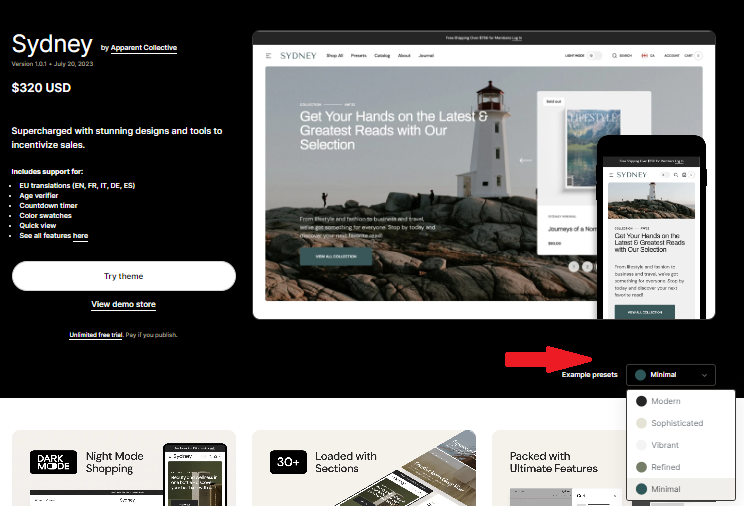
5. Shopify App Store
Shopify’s app store offers a really easy and effective way to customize your store and increase its functionality.
There are more than 8,000 free and paid apps to choose from their app store – way more than you’ll find on many other ecommerce platforms. You can use the apps to upgrade your store, like adding the ability to sell digital products or an email hosting element.
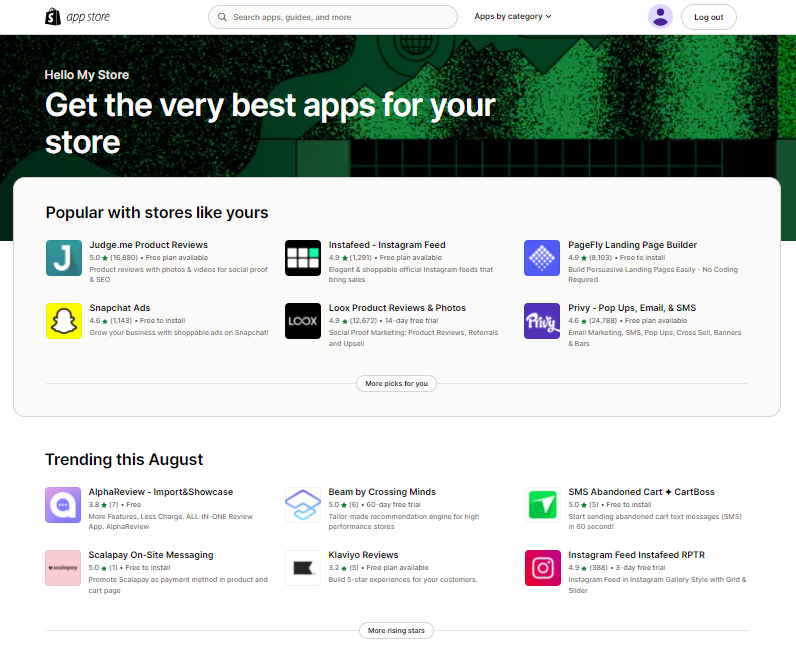
Don’t worry about scrolling through this massive array of apps all night because the platform makes things easier by recommending popular apps for stores like yours. The apps are also classified into six categories to explore and quickly find the apps you need.
Some apps that you will immediately find useful include store design apps like PageFly Landing Page Builder and management apps like Xero, Hubspot, and Zendesk.
If you’re unsure how to make your store look good or which apps to use, check out some Shopify website examples for ideas.
6. SEO and Marketing
Considering that most buyers (56% in 2023) find potential purchases through search engines like Google, getting your SEO right will be the key.
Shopify supports your store’s SEO performance through various on-page and off-page tools. For instance, the platform makes it easy to manage on-page SEO when addressing factors like alt text, headings, page titles, and meta descriptions.
You can also integrate your store with the paid Yoast SEO tool, which gives you an entire dashboard to monitor all aspects of on-page SEO.
Shopify gives you considerable control over off-page SEO. You can edit your store’s backend to select which URLs can be crawled by search engines and the rules around this. The platform also lets you set 301 redirects, ensuring users can be redirected to active pages whenever they hit broken links.
Shopify also has numerous built-in marketing tools to help you reach your target audience. These include the Shopify Blog, Shopify Forms, and a limited email marketing tool.
You can track campaigns, make necessary tweaks, and analyze your marketing efforts using the platform’s comprehensive analytics and marketing reports.
7. Hosting and Security
Shopify is a hosted platform, which means you don’t need to pay any money to host your store’s domain name. The entire platform is hosted on Shopify’s servers, all you need to do is log in to your store and start selling.
This also means gaining access to the advanced security features available to market-leading companies like Shopify. All the credit card transactions running through your store are secured with PCI-compliant features.
You also don’t need to worry that your apps or plugins may be outdated because Shopify deploys updates to the stores on its platform.
The platform also boasts high availability – a big deal for digital stores. For international websites with customers all over the world, it’s important for them to be able to access the products at any time.
8. 24/7 Customer Support
Shopify’s comprehensive customer support starts with the Help Center, which provides detailed explanations on many topics, from how to start selling to managing and expanding your store. The help materials are offered in 21 languages.
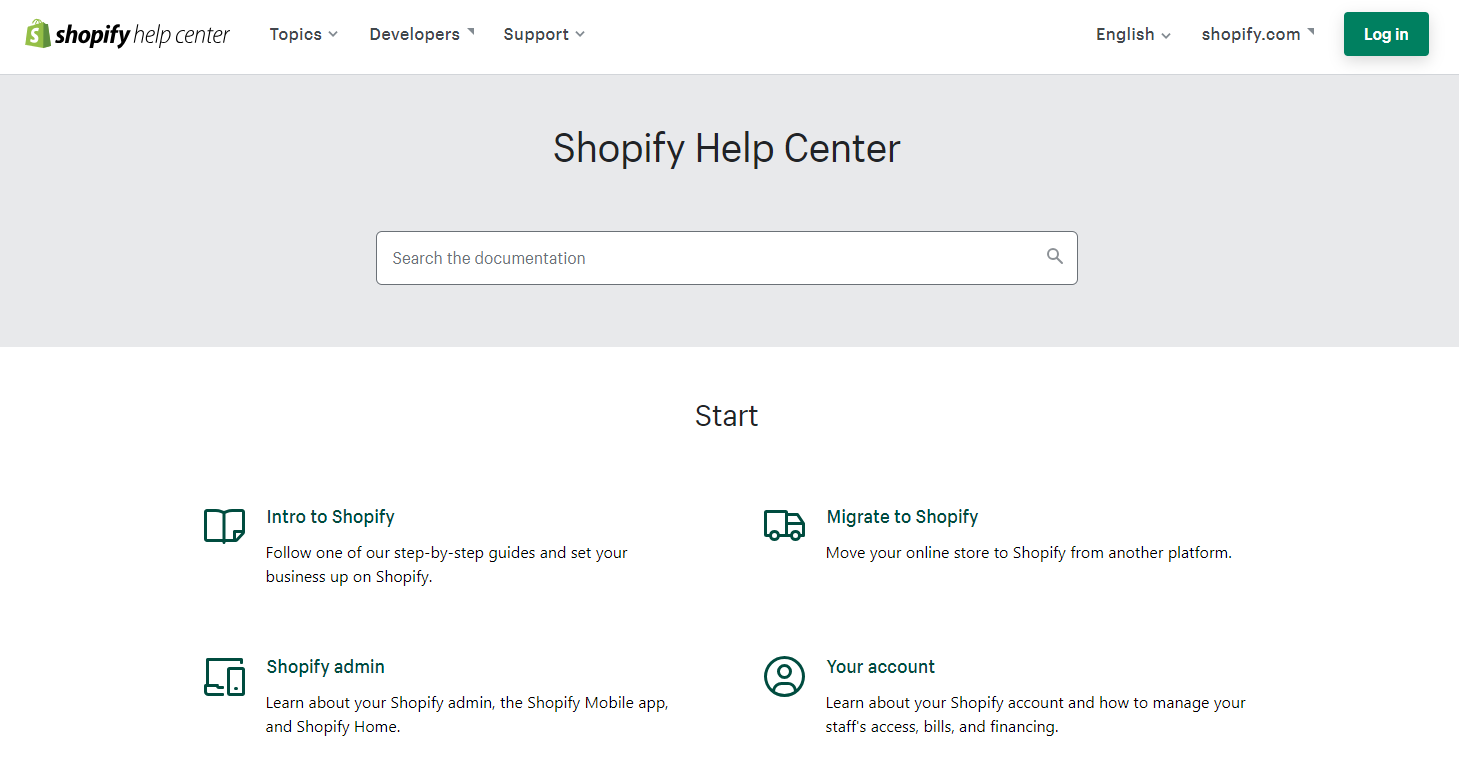
While the help materials are predominantly text-based, you’ll find most of the first-level support you require through the Help Center. For more detailed support, you may want to contact Shopify’s 24/7 support center via chat, email, or voice call. If you need hands-on support, it’s a great idea to reach out to the support center in order to speak with one of the platform’s representatives.
You should note that if you’re looking for really technical help, such as assistance with coding, the Community Forum on Shopify can be an excellent resource.
You’ll find numerous store owners and developers on the forum, so the more experienced ones can be a great help if you’re stuck on some technical subject.
Cons of Using Shopify
We now have an in-depth understanding of what’s great about Shopify. But no platform is perfect. Let’s look at some of the cons of using Shopify and what they might mean for your online business.
1. Pricing
New or upcoming store owners may find Shopify to be somewhat pricey, meaning they have to make a decision whether the expense is worth it. Shopify has three main pricing plans (as shown below). In addition, it has a Starter plan for $5 and a Shopify Plus package starting at $2,000 a month.

While the Starter plan is low-priced, this option is pretty limited. It works best if you plan to sell on social media using a link that sends buyers to a fairly basic store. If you prefer more value-added features like the ability to edit themes or have a blog, you’ll need to buy the Basic plan or higher.
In addition, while all the Shopify plans provide core ecommerce functionalities, some key features are limited to certain plans.
- Automation: Marketing automation is only available for users on the Basic plan or higher.
- Analytics: To generate standard analytics reports, you must be on the Shopify plan or higher.
- Shipping discounts: The higher your plan, the more discounts you get.
- Transaction fees: The higher your plan, the lower the fees you have to pay.
Ultimately, it’s down to each store owner to consider their finances and determine how to approach their Shopify subscription. It’s possible to plump for a lower-priced plan in exchange for only the core functionality you need, then go for higher plans as your business scales.
2. Limited Design Customization Options
While Shopify allows for customization at various levels, from drag-and-drop to back-end coding, the ability to customize is limited. This is partly due to the fact that Shopify uses an in-house coding language (Liquid).
No matter a seller’s coding expertise level, they most likely will be new to the Liquid language. This means you’ll have to spend time learning the platform’s coding language if you want to make granular edits to your Shopify website.
Everything from custom forms to standard blogging functionality requires coding if you’re unsatisfied with the standard features.
Additionally, Shopify does not offer a feature that lets buyers send files to you with details of their orders (such as an image they’d like to print on a mug). You need to code this functionality into your store or pay for an app.
3. Shopify Processing Fees
Shopify Payments is not available in all countries. Currently, it’s only available in 23 countries, including the US, New Zealand, Australia, Hong Kong SAR, Japan, Singapore, and most of Europe.
If you’re in a country where Shopify Payments isn’t available, you’ll have to use third-party payment gateways, which carry a transaction fee of up to 2% (or up to 5% on the Starter plan). In addition, transactions on Shopify attract a credit card processing fee. In the US, this fee can be up to 2.9% per transaction.
Shopify relies on numerous apps and templates to create its standout ecommerce experience. Unfortunately, many of these tools are paid, and the cost to access them can be prohibitive. You’ll regularly see themes that go for $300 plus and apps that go for three times that amount.
4. No Email Hosting
Email marketing plays a key role in the success of your online store. You need to be able to market to customers, send product order notifications, inform them of new releases, etc., and a robust email marketing function is vital to this.
However, Shopify does not provide email hosting, which can cause some complications in your email marketing efforts. This means without the use of apps, you’re limited to using emails that carry domain names from popular email providers like Gmail and YahooMail.
The problem with this is buyers are unlikely to take you seriously if you don’t have a professional email that carries your store or business name. Thankfully, there are ways that you can work around this obstacle.
If you have a domain name, which you can register with Shopify, you can set up a forwarding email address with most email providers like Zoho, G Suite, and MailChimp.
5. Difficult Exit
Although many sellers on Shopify never really consider leaving the platform, those who try find it a little difficult. The first obstacle to leaving Shopify is there is no clear pathway to terminating your account from your Shopify dashboard.
To close their account and deactivate their Shopify store, many find the need to first visit the Help Center for instructions on leaving. Again, there are no obvious categories devoted to leaving the platform. But a simple search with the prompt “close my account” brings up the instructions.
Helpfully, Shopify offers handy guidelines to ensure you don’t lose your precious data or get hit with surprise charges. You can export CSV files with all your key data: product info, customer data, orders, gift card codes, discount codes, and even your financial information.
Before you make your grand exit, you must also put in the effort to cancel any third-party invoices you routinely receive. Check and clear pending subscriptions relating to things like monthly app payments, third-party themes, etc – make a list and check it twice.
So, leaving Shopify isn’t a walk in the park, but with a bit of guidance and some manual data recovery, you can make a smooth getaway.
Key Takeaways
There you go. Now, you have the key information you require to make an informed decision on whether Shopify is right for you. As we’ve shown, the platform offers numerous advantages and outstanding features, such as:
| Shopify pros | Shopify cons |
| Ease of use | Expensive pricing |
| Customization | Limited design options |
| Shopify Payments | High processing fees |
| Theme variety | No email hosting |
| Shopify app store | Difficult exit |
| SEO and marketing | |
| Hosting and security | |
| 24/7 customer support |
It’s ultimately up to you to weigh the pros and cons of Shopify and come to a decision on whether the platform meets your business requirements.
Ready to ride the Shopify wave? Before you embark on this ecommerce adventure, explore our other articles on the best Shopify apps and tools that promise to catapult your sales and make marketing a breeze:

